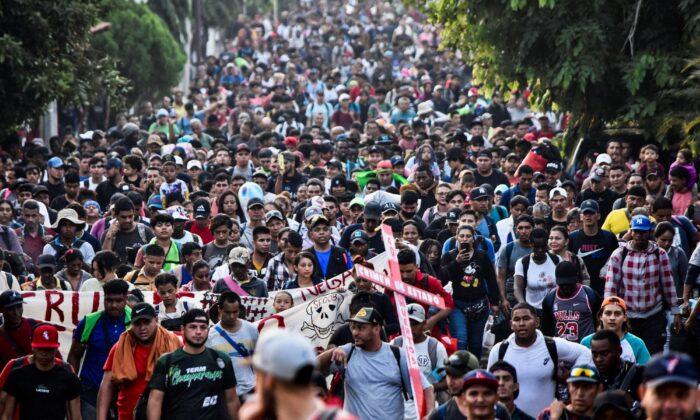About 3,000 migrants set out on April 23 in a large caravan from southern Mexico and began walking north in what organizers said was a protest demanding an end to detention centers like the one that burned down last month, killing dozens.
The migrants, mostly Venezuelans, started walking north early on April 23 from Tapachula, a city in Mexico close to the border with Guatemala.
The stated goal of the migrants is to reach Mexico City in about 10 days and appeal for the closure of detention centers.
Most caravans that started in southern Mexico have headed north toward the United States, with migrants often seeing such mass walks as a way to reach the U.S.–Mexico border.
“We joined the caravan to be safer and not be detained,” Yoani, a Venezuelan migrant who only gave his first name, said in an interview with Reuters.
Yoani said that, once in Mexico City, he and his family are hoping to speed up the legal process for onward travel.
It’s unclear how many of the protesters plan to continue on toward the United States.

Deadly Fire
Organizer Irineo Mújica told The Associated Press that the migrants are demanding the closure of Mexico’s immigration agency, which some have blamed for a March 27 fire at a detention center in Ciudad Juárez that killed 40 people and injured dozens more.“It could well have been any of us,” Salvadoran migrant Miriam Argueta said of those killed in the fire, according to AP. “In fact, a lot of our countrymen died. The only thing we are asking for is justice, and to be treated like anyone else.”
The fire on March 27 started when migrants set fire to foam mattresses when they found out they would be deported, according to Mexico President Andrés Manuel López Obrador.
Video footage of the fire showed three uniformed officials leaving the room and appearing to leave the migrants behind in locked cells as the fire spread.
Five people face homicide charges over the deadly blaze, including three immigration agents and a private security guard, as well as a Venezuelan man believed to have started the fire.
Mújica, a leader of the Pueblos Sin Fronteras activist group, called the detention centers “jails.”
“We are asking the government that justice be done to the killers, for them to stop hiding high-ranking officials,” Mújica told AP in Tapachula before the caravan set out on its trek north. “We are also asking that these jails be ended and that the National Immigration Institute be dissolved.”
Some caravan participants carried crosses or banners reading “The Government Killed Them,” referring to those who died in the fire.
After leaving at about dawn, the migrants made it to a town about nine miles north of Tapachula before settling in for the night.

Title 42
It comes as the Biden administration expects to lift Title 42 on May 11, although there are lawsuits attempting to keep it in place.The Trump-era policy, which was enacted during the COVID-19 pandemic, allows border agents to immediately deport people who have crossed the border into the United States unlawfully.
Illegal immigrants processed under Title 42 powers aren’t permitted to request asylum while in the United States and are removed from the country. The Title 42 program has been used more than 2.5 million times to block asylum claims.
The Department of Homeland Security (DHS) has been preparing for an influx of illegal immigrants when Title 42 is lifted. Initially, the program was slated to end on Dec. 21, 2022, but it was extended by a U.S. Supreme Court decision.
The department’s plan includes accelerated processing for illegal immigrants in custody on the border, more temporary detention tents, staffing surges, bolstering NGO capacity to receive people after they’ve been processed, and increased criminal prosecutions of smugglers.
DHS estimated that 9,000 to 14,000 migrants per day could try to enter the country illegally when the Title 42 policy ends.
The North American Congress on Latin America, which advocates for migrants, blamed overcrowded conditions at the Ciudad Juárez detention center on orders to arrest migrants in the city. It also blamed U.S. immigration policy, including Title 42.
“Without Title 42, those individuals would likely not have been in Mexico for the extended period that led to their apprehension in the streets of Juárez and detention in the ’shelter,'” the group said in a statement.
Besides lawsuits seeking to keep Title 42 in place, Republican senators recently introduced the “Stop Fentanyl Border Crossings Act,” which would add drug smuggling as an additional basis for Title 42 enforcement.
Fentanyl is now the leading cause of death for Americans aged 18 to 45.
“The uncontrolled flow of fentanyl from the southern border to our neighborhoods and communities must be stopped,” said Sen. Mike Crapo (R-Idaho), one of the bill’s co-sponsors.
“The soaring increase in drug overdose deaths is a public health crisis, and the federal government should have every tool available to combat drug smuggling and illegal border crossings into the United States.”





